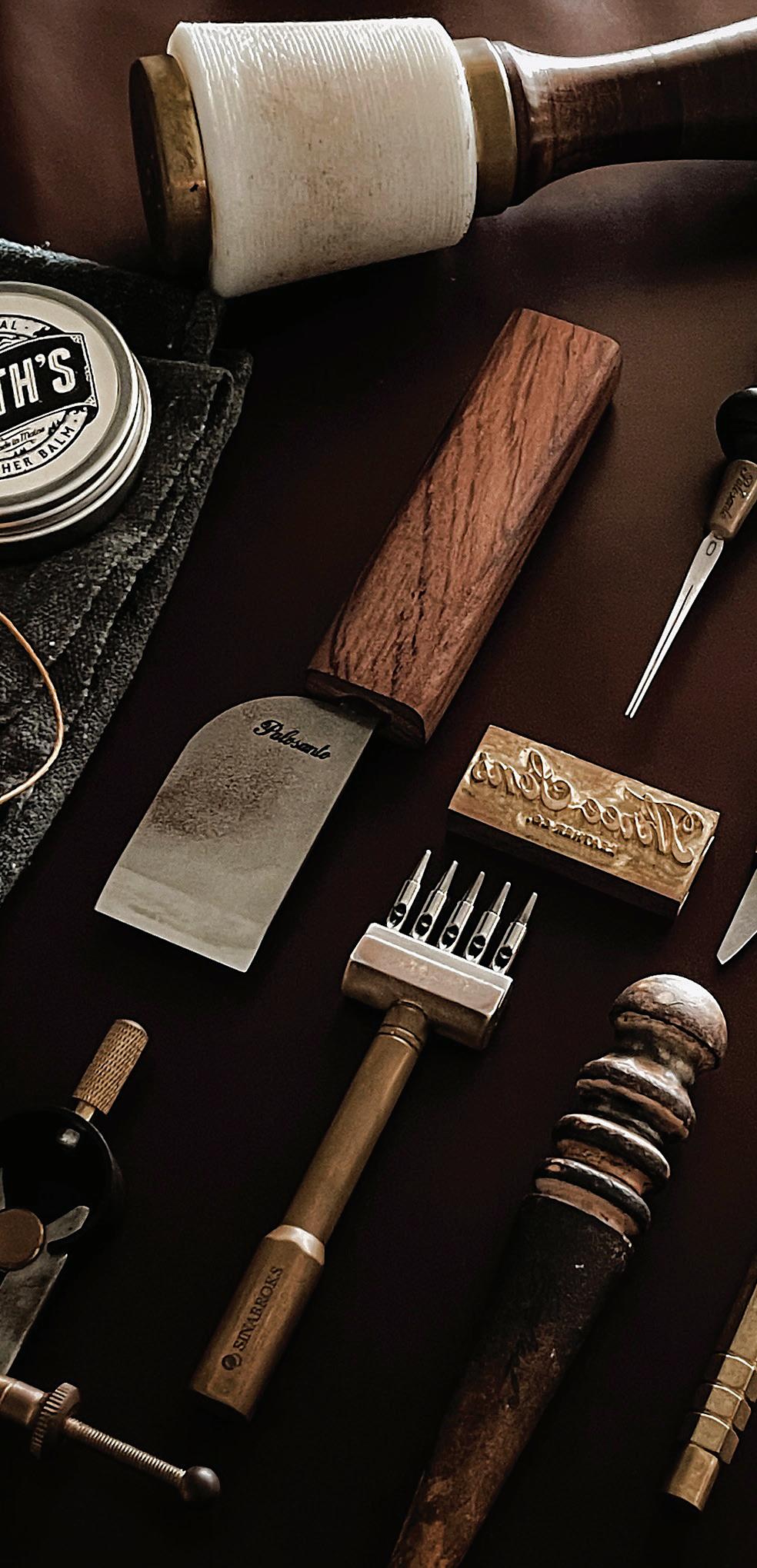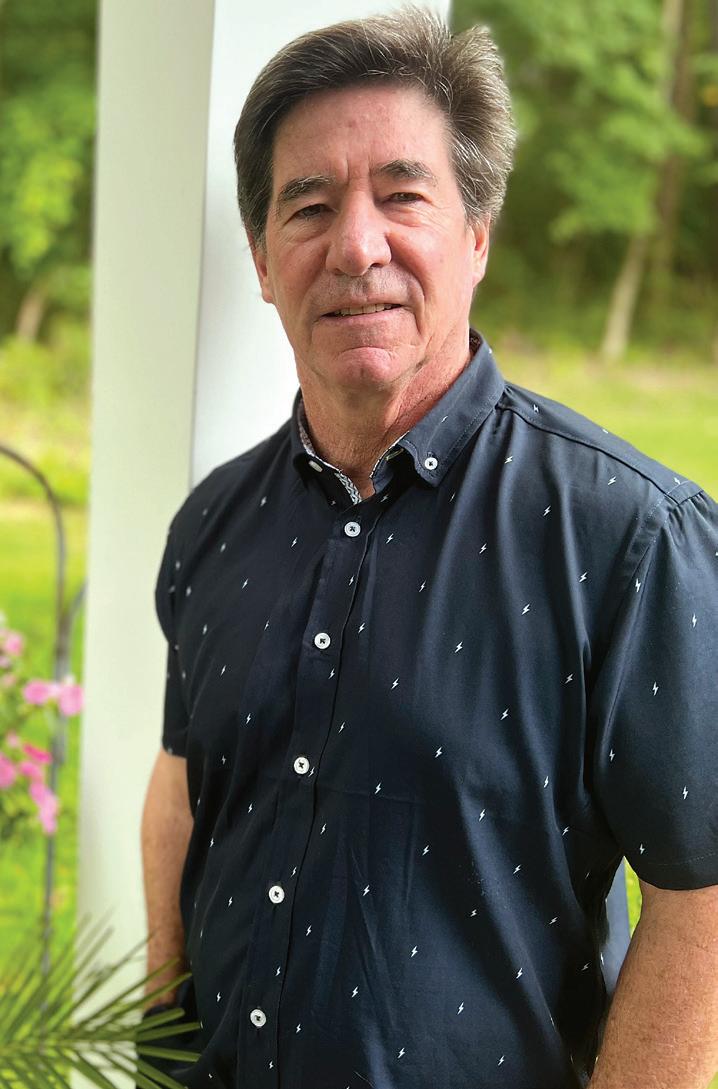
8 minute read
Belmont
COURTESY OF OHIO DEPARTMENT OF NATURAL RESOURCES Built to Last: Firefighter Seth Robinson turned a passion for leather working into a line of handcrafted products meant to stand the test of time. Writing History: The Paul Laurence Dunbar House Historic Site in Dayton shares the life story of the poet, who achieved acclaim around the world.
into the woods
The thick, second-growth forest at Barkcamp State Park in Belmont County offers an idea of what Ohio looked like prior to settlement. The state began acquiring land for the park in 1955, and a dam completed in 1963 led to the creation of Barkcamp Lake. The 1,005-acre park has five short hiking trails, an 8-mile multiuse trail and 24 miles of bridle trails. Its unusual name comes from a logging camp that stripped bark from trees and once operated in the area. 65330 Barkcamp Park Rd., Belmont 43718, ohiodnr.gov


Built to Last
Working as a full-time firefighter, Seth Robinson and his coworkers gravitate to leather products because of their durability. After ordering a work belt and wallet online that quickly started to fall apart, Robinson decided to take matters into his own hands and began leather working as a side pursuit.
By 2020, he was selling wallets to friends and family and had a passion for making them. It was therapeutic and different than his demanding job as a firefighter. He liked the controlled nature of the craft.
“I kind of fell in love with it, so it became the thing I do now in my downtime,” says Robinson, who lives in North Olmsted.
As a dad of three children — ages 8, 5 and 4 — he finds the silent time of crafting even more valuable. His business’s name, Three Sons Leather Co., was inspired by his kids, and the smallest wallet in the line is even named after his youngest son, Cole. Robinson also crafts belts, apparel and bags, including the Marie Crossbody, inspired by the middle name that his wife and mom share.
To make his signature wallets, Robinson uses a die cutter to create the desired shapes. He then cleans the edges, glues the pieces and stitches each up to finish. Although machines can quicken this process, he prefers a single piece of thread and handcrafting each, utilizing a saddle-stitch technique.
Intentionality and longevity are at the core of Robinson’s business. He says he has never had someone return a wallet because of poor stitching. (He would fix it for them if they did.) Robinson stands behind his products, knowing customers are spending their hard-earned money on them.
“My business slogan is ‘a legacy worth leaving,’” he says. “It ties back to raising boys and kids in a good way, but also … I want to leave a lasting piece.” — Kelly Powell




FASCINATING OBJECTS FROM OUR PAST
A room inside Dayton’s Paul Laurence Dunbar House Historic Site
Writing Paul Laurence Dunbar bought his Dayton home after becoming one of the first African American literary figures to achieve international acclaim. He purchased the house for his mother in 1904 History and lived there with her until he died of tuberculosis two years later. Dunbar had been sick for years prior, but he continued to Paul Laurence Dunbar’s Dayton write and completed his last works in the home. He wrote 12 books of poetry, as well as four novels and short stories during his 33 years, and his story is shared at the Paul home tells the story Laurence Dunbar House Historic Site, part of the National Park of the poet, who Service’s Dayton Aviation Heritage National Historical Park. achieved acclaim “There was such great injustice, especially during that time, in around the world. the United States, yet his writing brought people together,” says Angela Stewart, park ranger at the Paul Laurence Dunbar House and project manager of the Dunbar 150th celebration. “He was unafraid to speak out about the injustices and he did that in his poetry.”
Born from formerly enslaved parents, Dunbar was inspired to write in several forms of dialect, a style for which he is acclaimed today.He was a contemporary of prominent African Americans of his time such as Booker T. Washington and Frederick Douglass and inspired Harlem Renaissance writers as well as poet Maya Angelou, who borrowed the last line from his poem “Sympathy” for the title of her 1969 autobiography, I Know Why the Caged Bird Sings.
Visitors can take a tour of the home, which has been restored to the era in which Dunbar lived there. A nearby visitor center shows an 18-minute film, and exhibits and artifacts detail the writer’s life, works and relationships.
“He was connected with a lot of different writers who admired his work,” Stewart adds. “There are several books in his house given to him by different prominent writers of that time.” —Denise Cameron
OCTAGONAL HARDWARE CABINET Made by American Bolt & Screw Case Co. of Dayton
Metal screws were used as early as the 15th century in Europe, but their production was a laborious process. Blacksmiths would forge nails workers would have to file by hand, making a slot in the head and creating the threads.
New machinery and manufacturing techniques in the 19th century meant fasteners could be mass produced quickly. Hardware stores at the turn of the century were tasked with stocking large quantities of metal fittings in an assortment of types and sizes. The American Bolt & Screw Case Co. of Dayton made wooden organizational cabinets that were sold nationwide, but one design radically changed how bolts and screws were accessed.
Patented May 12, 1903, by George W. Chaffin, the octagonal cabinet featured wedge-shaped drawers on each of its faces and rotated around a central axis. Each drawer was stenciled with numbers, corresponding with the measurements of the screws, bolts and nuts therein. Many cabinets featured decorative elements that belied the mundane nature of the items they held. — Richard “Jeff” Jeffers
$2,375
SOLD AT AUCTION
Richard Jeffers is the owner of Garth’s Auctioneers & Appraisers in Columbus.
See our Social Side.
Find Ohio Magazine on
Find road trip inspiration, learn about giveaways and events, and connect with the beauty, the adventure and the fun of Ohio.




Game of Life
Retired Cincinnati Enquirer columnist Paul Daugherty talks about his 34 years covering sports.
Longtime Cincinnati Enquirer columnist Paul Daugherty didn’t write about sports, not really. He wrote about people. “I’m not all that interested in the games by themselves,” says Daugherty, who covered sports in Cincinnati for 34 years before retiring over the summer. “I’m not a Writer Paul Daugherty focuses on telling the human stories behind sports. “I wrote about stuff I thought people might relate to.” sports fanatic. It’s the people that play them that interest me.” During his tenure, Daugherty covered the 1990 Reds World Series, the Olympics, more than 20 Masters tournaments, and two Bengals Super Bowl appearances. But it was his more personal columns that built him a loyal following. He often wrote about his family, including his daughter Jillian, who has Down syndrome and whose story was the crux of his 2015 memoir, An Uncomplicated Life: A Father’s Memoir of His Exceptional Daughter.
In retirement, Daugherty has resurrected his popular online column, “The Morning Line,” which he now publishes independently on Substack. We caught up with “Doc” to talk with him about his favorite Cincinnati sports moment, being “canceled,” and the plight of Cincinnati fandom. — Michelle Sullivan Hopkins
What was the most memorable sports moment you ever covered?
A: The coolest local thing I ever saw was [Reds center fielder] Eric Davis hitting a home run in the first inning of the first game in the 1990 World Series against the A’s. There was this huge build up about how great Oakland was and how the Reds were just in the way of them winning a championship. [Davis’] home run dented the whole invincibility thing, and the Reds swept the series. I have never been at an event here with that kind of electricity or emotion.

In 2021, you made news for a question you asked Naomi Osaka at a press conference about balancing fame and tennis. Her agent called you “a bully.” Were you surprised by the fallout?
A: I was canceled. But the ironic thing was, she had no problem answering the question. She gave a thoughtful response, and we learned a little about her, and that’s my job, right?
Cincinnati fans famously have a love-hate relationship with our teams. What have you learned about us over the years?
A: There’s a learned and earned fatalism to the Cincinnati sports fan. I used the Charlie Brown football analogy a million times because it’s absolutely perfect. Fans here are great. All these people say, “I’m never going to another Reds or Bengals game again,” and they go back. Because it’s in their blood. They’ve earned their cynicism through their loyalty, and they still spend their entire sports lives waiting for the other shoe to drop.
DATEBOOK
BOB CAREY Wildest Dreams: The Columbus Museum of Art and The Maurice Sendak Foundation showcase the author and artist who gave us Where the Wild Things Are. TRANS-SIBERIAN ORCHESTRA

Nov. 19–Dec. 30, Multiple locations
From the first sounds of the electric guitar and chorus of strings to the pulsating lasers and synchronized lights, the Trans-Siberian Orchestra rocks audiences straight into the holiday season each year. Renowned for its high-energy rock operas and live shows, the band returns to six cities across Ohio this month and next to perform its roster of seasonal favorites, like the iconic “Christmas Eve (Sarajevo 12/24).” trans-siberian.com
Calendar of Events: Your holiday plans start here. Check out our guide to exhibitions, shows and other happenings scheduled between now and the end of December.

